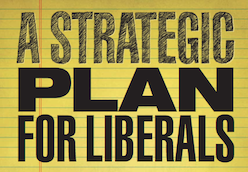This piece is part of the Prospect's series on progressives' strategy over the next 40 years. To read the introduction, click here.
If we're going to pursue a long-term strategy, we need an organization that can act strategically. Lewis Powell had a powerful Chamber of Commerce that represented a relatively unified business sector. What he and the chamber lacked were grassroots organizations, think tanks, and media outlets capable of legitimating and promoting their interests. His memo was therefore designed to create such organizations, even if many of them would prove to be made out of Astroturf.
Contemporary liberals confront the opposite problem. We have innumerable grassroots organizations, think tanks, and media outlets, but they're at best divided and at worst impotent. Consider, for example, the labor movement-or perhaps I should say labor movements. The U.S. boasts not only two competing union federations-the AFL-CIO and Change to Win-but also a host of independent unions, worker centers, labor- and public-interest law firms, and advocacy groups working to defend the interests of American workers. But they don't necessarily act in concert, and they frequently work at cross-purposes.
Nor is labor exceptional. A number of leading environmental organizations-including the League of Conservation Voters, the National Resources Defense Council, the National Wildlife Federation, and the Sierra Club-recently joined forces to defend the Senate seat being vacated by retiring New Mexico Democrat Jeff Bingaman. What's striking about the example is the unprecedented nature of the coalition. "We've never done this in a Senate race before," explained Navin Nayak of the League of Conservation Voters, prompting the obvious question: Why not?
Similar divisions pervade the women's, LGBT, civil-rights, peace, and consumer movements, not to mention the many faith-based and community organizations committed to a social-justice agenda. The problems are multiplied when different values conflict with each other, as we've seen in the traditional tension between organized labor and the environmental movement.
But for all of our many differences, we tend to come together to support the Democratic Party at election time, albeit with varying degrees of enthusiasm. The problem is that we go our separate ways afterward, and in so doing squander resources and opportunities that we can't afford to waste.
What we need, therefore, is an organization capable of herding these cats into a coherent movement, one that can recognize our commonalities, respect our differences, and make sure that the former trump the latter over time. What would such an organization look like? It should be independent of the Democratic Party, in part to avoid the myopia that will almost inevitably beset an organization tied so tightly to the electoral calendar and in part to ensure compliance with campaign-finance laws. The actual architecture of the organization would need to be worked out over time. Who would be eligible for membership? On what terms? What funding sources would be available? And what would the decision-making process look like? Answers to such questions aren't easy to come by, but they're long overdue. The American left has been disjointed for far too long, and the country has paid an enormous price for our disunity. It's time we took a lesson from the late Justice Powell, who long ago noted that "strength lies in organization, in careful long-range planning and implementation, in consistency of action over an indefinite period of years, in the scale of financing available only through joint effort, and in the political power available only through united action and national organizations."




